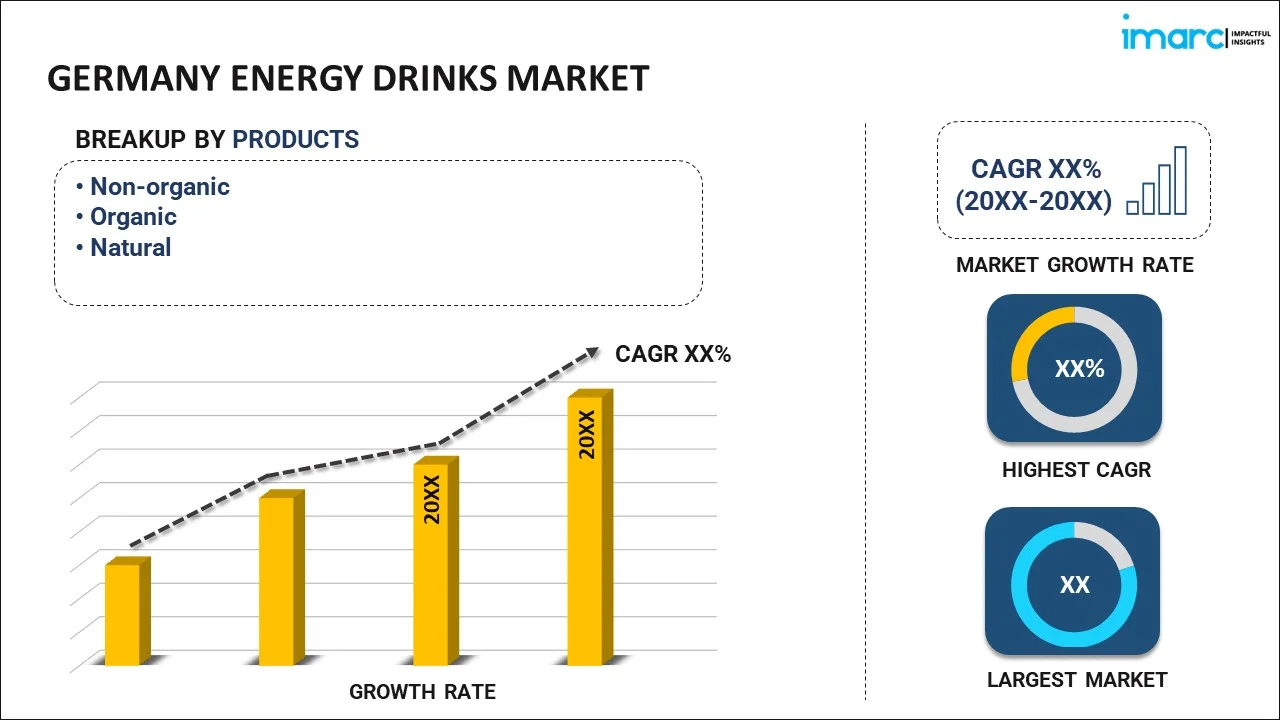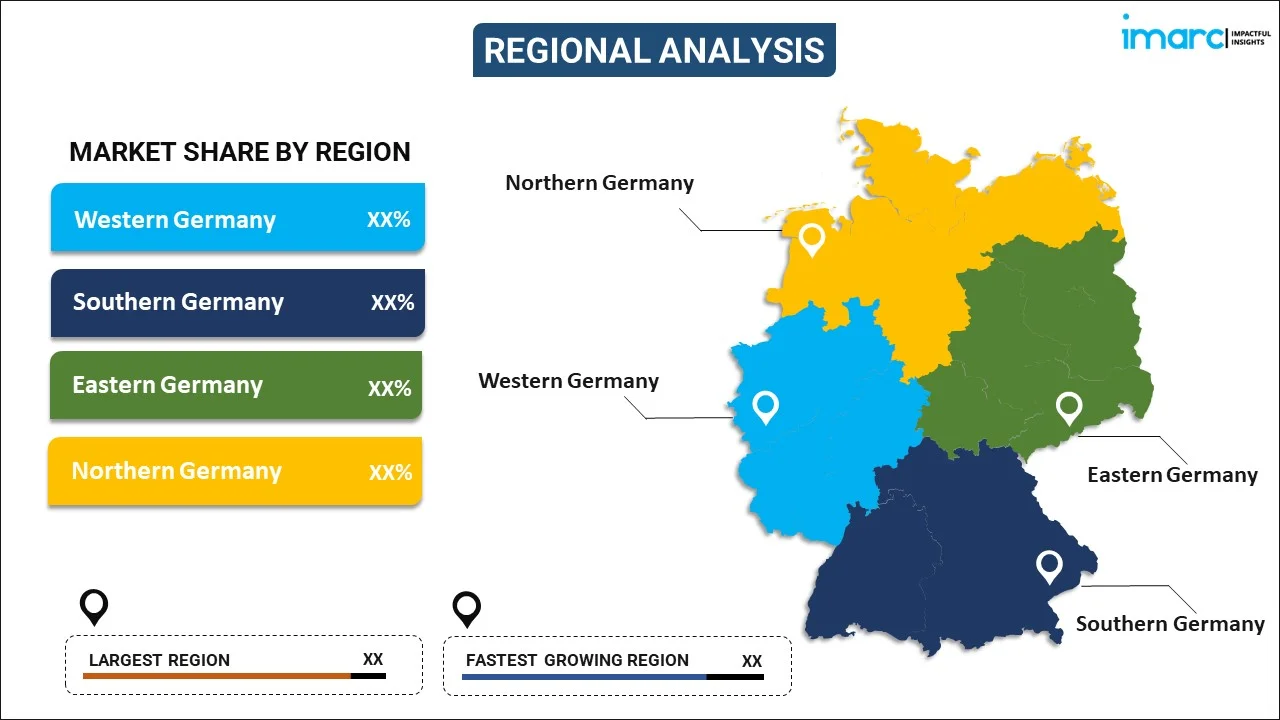
Germany Energy Drinks Market Report by Product (Non-organic, Organic, Natural), Target Consumer (Teenagers, Adults, Geriatric Population), Distribution Channel (Offline, Online), and Region 2025-2033
Germany Energy Drinks Market Overview:
The Germany energy drinks market size reached USD 2.2 Billion in 2024. Looking forward, IMARC Group expects the market to reach USD 3.4 Billion by 2033, exhibiting a growth rate (CAGR) of 5.09% during 2025-2033. The market is driven by the rising level of stress and anxiety among people, as caffeine and stimulating components in energy drinks help reduce them, along with the thriving e-commerce industry, which gives access to people to a wide variety of energy drinks.
|
Report Attribute
|
Key Statistics
|
|---|---|
|
Base Year
|
2024 |
|
Forecast Years
|
2025-2033
|
|
Historical Years
|
2019-2024
|
| Market Size in 2024 | USD 2.2 Billion |
| Market Forecast in 2033 | USD 3.4 Billion |
| Market Growth Rate (2025-2033) | 5.09% |
Germany Energy Drinks Market Trends:
Growing Level of Anxiety Among People
As per the National Library of Medicine’s report 2023, the percentage of people suffering from anxiety in Germany increased from 7.2% in 2021 to 11.1% in 2022. Individuals suffering from anxiety or stress may seek strategies to cope with their symptoms, and some may resort to energy drinks as a kind of self-treatment. Caffeine and stimulating components in energy drinks can provide brief fatigue relief while also making people feel more alert and invigorated, which may appeal to those suffering from anxiety-related lethargy or low energy levels. Individuals may experience worry and tiredness as a result of their modern lifestyle, which includes long working hours, academic obligations, and social stressors. In such a situation, energy drinks may be viewed as a quick and convenient way to counteract exhaustion and sustain productivity, particularly during challenging periods.
Energy drink companies frequently target young adults and people who lead active lifestyles in their marketing campaigns. Companies that associate their products with themes such as vitality, performance, and conquering problems may appeal to consumers looking for solutions to cope with stress and anxiety in their daily lives.
Thriving E-Commerce Industry
According to the International Trade Administration’s report 2023, the total sales via e-commerce in Germany was estimated to be USD 141.2 billion in 2022, which is 11% higher as compared to 2021. E-commerce platforms allow people to purchase energy drinks from the comfort of their own homes or offices. This convenience feature attracts to busy people who may not have the time to visit real establishments. Online retail platforms allow energy drink brands to access a larger audience outside of their typical regional restrictions. This increased reach enables businesses to reach new market groups and demographics, such as consumers in rural areas or those who have restricted access to physical outlets.
E-commerce platforms frequently offer a diverse selection of energy drink brands, flavors, and container sizes, giving consumers more options than traditional retail stores. This variety in product choices enables people to explore numerous options and locate products that best meet their interests and needs. E-commerce platforms use data analytics and algorithms to provide users personalized product suggestions based on their browsing and purchasing history. This personalized strategy helps consumers find new energy drink brands that match their interests and preferences, resulting in increased sales and customer loyalty. Some e-commerce sites provide subscription services for energy drinks, allowing individuals to receive regular deliveries of their favorite beverages at a reduced cost. This subscription model encourages repeat purchases and assures a consistent stream of revenue for energy drink companies.
Germany Energy Drinks Market News:
- July 2023: German social media star launched new 'calorie-free' energy drink, GÖNRGY, in collaboration with REWE and Kaufland supermarkets. This drink will be available in three flavors at Kaufland and REWE, including Raspberry Cheesecake, Blueberry Coconut and Tropical Exotic.
- March 2024: Monster Energy Ultra has released Fantasy Ruby Red, the latest low sugar flavor to join the Monster Energy Ultra roster, featuring a first-of-its-kind immersive augmented reality (AR) experience displaying custom can art.
Germany Energy Drinks Market Segmentation:
IMARC Group provides an analysis of the key trends in each segment of the market, along with forecasts at the country level for 2025-2033. Our report has categorized the market based on product, target consumer, and distribution channel.
Product Insights:

- Non-organic
- Organic
- Natural
The report has provided a detailed breakup and analysis of the market based on the product. This includes non-organic, organic, and natural.
Target Consumer Insights:
- Teenagers
- Adults
- Geriatric Population
A detailed breakup and analysis of the market based on the target consumer have also been provided in the report. This includes teenagers, adults, and geriatric population.
Distribution Channel Insights:
- Offline
- Supermarket/Hypermarket
- Mass Merchandiser
- Drug Store
- Food Service/Sports Nutrition Chain
- Others
- Online
The report has provided a detailed breakup and analysis of the market based on the distribution channel. This includes offline (supermarket/hypermarket, mass merchandiser, drug store, food service/sport nutrition chain, and others) and online.
Regional Insights:

- Western Germany
- Southern Germany
- Eastern Germany
- Northern Germany
The report has also provided a comprehensive analysis of all the major regional markets, which include Western Germany, Southern Germany, Eastern Germany, and Northern Germany.
Competitive Landscape:
The market research report has also provided a comprehensive analysis of the competitive landscape. Competitive analysis such as market structure, key player positioning, top winning strategies, competitive dashboard, and company evaluation quadrant has been covered in the report. Also, detailed profiles of all major companies have been provided.
Germany Energy Drinks Market Report Coverage:
| Report Features | Details |
|---|---|
| Base Year of the Analysis | 2024 |
| Historical Period | 2019-2024 |
| Forecast Period | 2025-2033 |
| Units | Billion USD |
| Scope of the Report | Exploration of Historical and Forecast Trends, Industry Catalysts and Challenges, Segment-Wise Historical and Predictive Market Assessment:
|
| Products Covered | Non-organic, Organic, Natural |
| Target Consumers Covered | Teenagers, Adults, Geriatric Population |
| Distribution Channels Covered |
|
| Regions Covered | Western Germany, Southern Germany, Eastern Germany, Northern Germany |
| Customization Scope | 10% Free Customization |
| Post-Sale Analyst Support | 10-12 Weeks |
| Delivery Format | PDF and Excel through Email (We can also provide the editable version of the report in PPT/Word format on special request) |
Key Questions Answered in This Report:
- How has the Germany energy drinks market performed so far and how will it perform in the coming years?
- What has been the impact of COVID-19 on the Germany energy drinks market?
- What is the breakup of the Germany energy drinks market on the basis of product?
- What is the breakup of the Germany energy drinks market on the basis of target consumer?
- What is the breakup of the Germany energy drinks market on the basis of distribution channel?
- What are the various stages in the value chain of the Germany energy drinks market?
- What are the key driving factors and challenges in the Germany energy drinks?
- What is the structure of the Germany energy drinks market and who are the key players?
- What is the degree of competition in the Germany energy drinks market?
Key Benefits for Stakeholders:
- IMARC’s industry report offers a comprehensive quantitative analysis of various market segments, historical and current market trends, market forecasts, and dynamics of the Germany energy drinks market from 2019-2033.
- The research report provides the latest information on the market drivers, challenges, and opportunities in the Germany energy drinks market.
- Porter's five forces analysis assist stakeholders in assessing the impact of new entrants, competitive rivalry, supplier power, buyer power, and the threat of substitution. It helps stakeholders to analyze the level of competition within the Germany energy drinks industry and its attractiveness.
- Competitive landscape allows stakeholders to understand their competitive environment and provides an insight into the current positions of key players in the market.
Need more help?
- Speak to our experienced analysts for insights on the current market scenarios.
- Include additional segments and countries to customize the report as per your requirement.
- Gain an unparalleled competitive advantage in your domain by understanding how to utilize the report and positively impacting your operations and revenue.
- For further assistance, please connect with our analysts.
 Inquire Before Buying
Inquire Before Buying
 Speak to an Analyst
Speak to an Analyst
 Request Brochure
Request Brochure
 Request Customization
Request Customization




.webp)




.webp)












